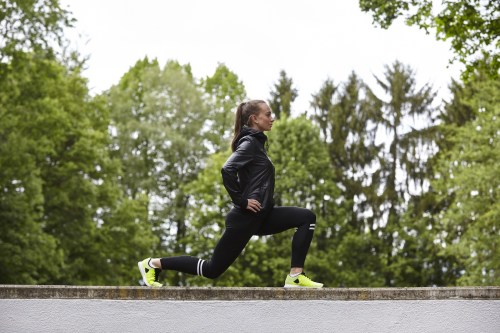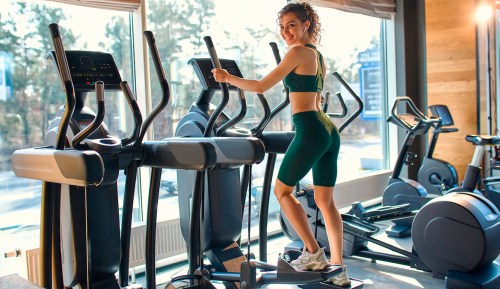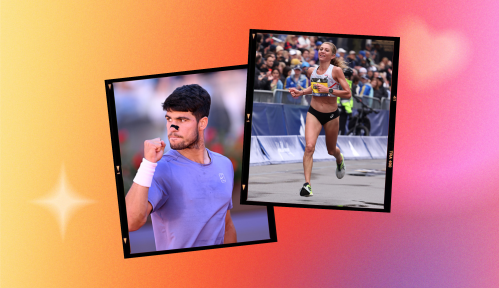3 upgrades that will turn basic lunges into a full-body burn
There are a variety of ways to upgrade your lunges to feel a more intense, full-body burn. Trainer Erin Bailey provides her fave lunge workouts to try.

Out of all the workout moves that I have done in my life, lunges are far-and-away the ones that trainers love to make even harder. I’ll often be trying to merely survive a lower body workout when, after instructing the class to do a set of simple lunges, the instructor all of a sudden takes things up a notch.
Lunges are hard enough, honestly—I mean, they’re firing up your glutes, quads, hamstrings, and calves (AKA your entire lower trunk), and even your abs and back. They may look simple, but after a few rounds, they’re deceivingly difficult and they majorly burn. So when a trainer adds in something like a bicep curl or weights—or TBH any other upgrade—it becomes seriously intense.
“Lunges are a great movement to work your entire lower body and your core to help you stabilize,” says Erin Bailey, head trainer at Asics studio. “There are so many varieties of ways you can perform lunges to target different muscles, and the main reason they’re one of my favorites is because they require no equipment.”
Though they’re just a staple lower body move, they feel extra hard—as compared to, say, squats—because they’re isolating one leg at a time. “Because you perform lunges one leg at a time, the movement creates an element of stability—so your core engages to keep you from falling over,” says Bailey. (Ah, that explains why I’m always so wobbly.) “Our core is our main stabilizer, which is why it’s so important to strengthen and focus on engaging with movements like lunges.”
“Because you perform lunges one leg at a time, the movement creates an element of stability—so your core engages to keep you from falling over.” —Erin Bailey
The most basic lunge upgrades are the various directions you can take them in. “Different types of lunges tend to focus more heavily on certain muscles,” says Bailey. “For example, reverse lunges target more of your glutes, while forward lunges hit more of your quads.” The reason why they’re a trainer fave for building on is because they make for a good base move for creating a full-body workout. “I love to combine lunges with bicep curls, but I have people hold the lunge with their knee hovering above the ground, perform the full bicep curl, and then stand up,” says Bailey. “That way they just have to perform the lunge and then intensified the movement with an isometric hold.”
Also, like squats that end in a shoulder press, lunge upgrades (like the lunge-bicep curl combo) work more of your muscles in less time. “They give you more bang for your buck,” says Bailey. “I’m all about an efficient workout, with the shortest amount of time and the most amount of energy exerted. Adding an upper body movement to a lunge means you’re engaging your full body so that you can be in and out of the gym in less time.” Speak to me.
To try out some of Bailey’s fave full-body lunge combos, keep scrolling.
Plyometric lunges: Anything plyometric instantly adds an all-over burn, along with a spike in your cardio. “These are when you jump in between your lunges in order to switch your legs to the opposite lunge position,” says Bailey, who admits these are hard AF. This kind of lunge focuses more on your quads and glutes to drive power and get a lift in your jump.
Lateral lunges: Forward and reverse lunges are great and all, but laterals are optimal for working different muscles. “We as humans do so much front to back movement between walking and running—we don’t often train side to side,” says Bailey. “Lateral lunges help strengthen your glutes and the little muscles around your knees to help prevent injuries, especially for big-time runners.” According to her, these are also firing up your inner and outer thighs, which are traditionally harder to reach.
Step up lunges: You’ll need some sort of step or platform for these leg-burners. “Find a box, a bench, or a chair, and take your lunges up,” recommends Bailey. “These really target your glutes, with your quads coming in secondary.” For all of these, she says to try three sets of 10 to 12 reps each. As you start to master the moves, “feel free to add dumbbells or hold a kettlebell to make it more difficult,” says Bailey. Just be ready to limp the next day.
Now that you’ve become a lunging pro, here’s how to do a proper squat. And these are tips for how to make push-ups easier.










